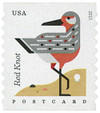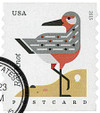
# 4997 - 2015 35c Coastal Birds: Red Knot, coil
U.S. # 4997
2015 35¢ Red Knot
Coastal Birds Coil
Admiral Robert Peary discovered nests of the red knot while making his way to the North Pole in 1909. The bird breeds in the Arctic, but winters on the southern tip of South America, giving it one of the longest migrations of any bird.
The red knot eats enough to double its body weight in anticipation of its 9,300-mile journey. Its flight muscles enlarge while the leg muscles shrink. Great flocks of hundreds of birds migrate together. They may fly over 1,500 miles before resting. Though they usually eat clams and mussels whole – including the shell – during migration, the red knot relies on easily digested food to gain energy for the next leg of its trip.
One popular resting place for the species of red knot that lives in the Western Hemisphere is the Delaware Bay. Its arrival corresponds with the time of year when the horseshoe crabs lay their eggs, providing an easy meal for the birds.
In the early 2000s, the horseshoe crab harvest increased. Scientists soon noticed a sharp decrease in the red knot population. Today, measures are in place to limit the harvest to only male horseshoe crabs during that season. Experts hope this will help the red knot recover to its previous population size.
The 2015 Coastal Birds stamps feature stylized illustrations by Tyler Lang and were designed by Greg Breeding.
Value: 35¢ Postcard Rate
Issued: June 1, 2015
First Day City: Kansas City, MO
Type of Stamp: Definitive
Printed by: Ashton Potter
Method: Offset with microprinting in coils of 100
Perforation: Serpentine Die Cut 9 ½ Vertically
Self-Adhesive
Quantity Printed: 150,000,000 stamps
The 2015 Coastal Birds were the first postcard rate issues to be released as Forever stamps (with “Postcard” replacing the denomination, so it’s clear what the stamps are to be used for.
U.S. # 4997
2015 35¢ Red Knot
Coastal Birds Coil
Admiral Robert Peary discovered nests of the red knot while making his way to the North Pole in 1909. The bird breeds in the Arctic, but winters on the southern tip of South America, giving it one of the longest migrations of any bird.
The red knot eats enough to double its body weight in anticipation of its 9,300-mile journey. Its flight muscles enlarge while the leg muscles shrink. Great flocks of hundreds of birds migrate together. They may fly over 1,500 miles before resting. Though they usually eat clams and mussels whole – including the shell – during migration, the red knot relies on easily digested food to gain energy for the next leg of its trip.
One popular resting place for the species of red knot that lives in the Western Hemisphere is the Delaware Bay. Its arrival corresponds with the time of year when the horseshoe crabs lay their eggs, providing an easy meal for the birds.
In the early 2000s, the horseshoe crab harvest increased. Scientists soon noticed a sharp decrease in the red knot population. Today, measures are in place to limit the harvest to only male horseshoe crabs during that season. Experts hope this will help the red knot recover to its previous population size.
The 2015 Coastal Birds stamps feature stylized illustrations by Tyler Lang and were designed by Greg Breeding.
Value: 35¢ Postcard Rate
Issued: June 1, 2015
First Day City: Kansas City, MO
Type of Stamp: Definitive
Printed by: Ashton Potter
Method: Offset with microprinting in coils of 100
Perforation: Serpentine Die Cut 9 ½ Vertically
Self-Adhesive
Quantity Printed: 150,000,000 stamps
The 2015 Coastal Birds were the first postcard rate issues to be released as Forever stamps (with “Postcard” replacing the denomination, so it’s clear what the stamps are to be used for.








